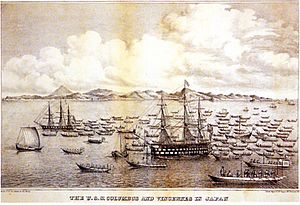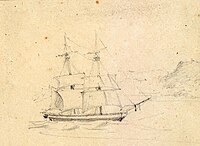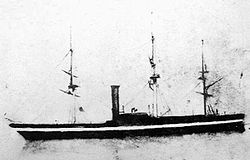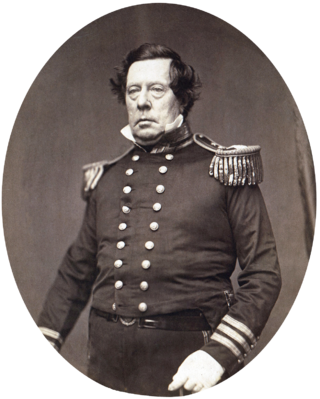
Matthew Calbraith Perry was an American naval officer who commanded ships in several wars, including the War of 1812 and the Mexican–American War. He played a leading role in the Perry Expedition that ended Japan's isolationism and the Convention of Kanagawa between Japan and the United States in 1854.

The first USS Powhatan was a sidewheel steam frigate in the United States Navy during the American Civil War. She was named for Powhatan, a Native American chief of eastern Virginia. She was one of the last, and largest, of the United States Navy's paddle frigates.

James Biddle, of the Biddle family, brother of financier Nicholas Biddle and nephew of Capt. Nicholas Biddle, was an American commodore. His flagship was USS Columbus.

Joel Abbot was a U.S. naval officer who served notably in the War of 1812, and commanded a ship during Commodore Perry's 1853-1854 visit to Japan. Commodore Joel Abbot was Admiral Matthew C. Perry's second in command when they opened Japan in 1853–1854.

The second USS Macedonian, was a three-masted, wooden-hulled sailing frigate of the US Navy, carrying 36 guns. Rebuilt from the keel of the first Macedonian at Gosport Navy Yard, Portsmouth, Virginia beginning in 1832, the new Macedonian was launched and placed in service in 1836, with Captain Thomas ap Catesby Jones in command.

The first John Adams was originally built in 1799 as a frigate for the United States Navy, converted to a corvette in 1809, and later converted back to a frigate in 1830. Named for American Founding Father and president John Adams, she fought in the Quasi-War, the First and Second Barbary Wars, the War of 1812, the Mexican–American War and the American Civil War.
USS Plymouth was a sloop-of-war constructed and commissioned just prior to the Mexican–American War. She was heavily gunned, and traveled to Japan as part of Commodore Matthew C. Perry's effort to force Japan to open her ports to international trade. She also served in European and Caribbean waters and, later in her career, she was used to train midshipmen.
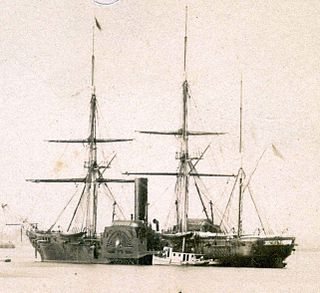
USS Susquehanna, a sidewheel steam frigate, was the first ship of the United States Navy to be named for the Susquehanna River, which rises in Lake Otsego in central New York and flows across Pennsylvania and the northeast corner of Maryland emptying into the Chesapeake Bay.

The Pacific Squadron was part of the United States Navy squadron stationed in the Pacific Ocean in the 19th and early 20th centuries. Initially with no United States ports in the Pacific, they operated out of storeships which provided naval supplies and purchased food and obtained water from local ports of call in the Hawaiian Islands and towns on the Pacific Coast. Throughout the history of the Pacific Squadron, American ships fought against several enemies. Over one-half of the United States Navy would be sent to join the Pacific Squadron during the Mexican–American War. During the American Civil War, the squadron was reduced in size when its vessels were reassigned to Atlantic duty. When the Civil War was over, the squadron was reinforced again until being disbanded just after the turn of the 20th century.
USS Germantown was a United States Navy sloop-of-war in commission for various periods between 1847 and 1860. She saw service in the Mexican–American War in 1847–1848 and during peacetime operated in the Caribbean, in the Atlantic Ocean off Africa and South America, and in East Asia. Scuttled at the outbreak of the American Civil War in 1861, she was captured and refloated by the Confederate States of America and placed in service with the Confederate States Navy as the floating battery CSS Germantown before again being scuttled in 1862.

USS Peacock was a sloop-of-war in the United States Navy during the War of 1812.

The second USS Lexington was a sloop in the United States Navy built at the New York Navy Yard in Brooklyn, New York, in 1825; and commissioned on 11 June 1826, Master Commandant William B. Shubrick in command.

The Perry Expedition was a diplomatic and military expedition in two separate voyages to the Tokugawa shogunate by warships of the United States Navy. The goals of this expedition included exploration, surveying, and the establishment of diplomatic relations and negotiation of trade agreements with various nations of the region. Opening contact with the government of Japan was considered a top priority of the expedition, and was one of the key reasons for its inception.
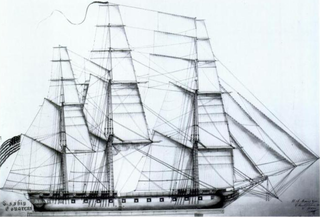
The West Indies Squadron, or the West Indies Station, was a United States Navy squadron that operated in the West Indies in the early nineteenth century. It was formed due to the need to suppress piracy in the Caribbean Sea, the Antilles and the Gulf of Mexico region of the Atlantic Ocean. This unit later engaged in the Second Seminole War until being combined with the Home Squadron in 1842. From 1822 to 1826 the squadron was based out of Saint Thomas Island until the Pensacola Naval Yard was constructed.
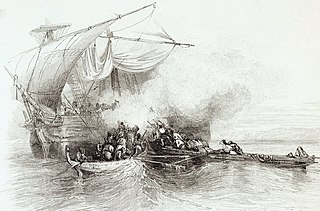
Aegean Sea anti-piracy operations began in 1825 when the United States government dispatched a squadron of ships to suppress Greek piracy in the Aegean Sea. The Greek civil wars of 1824–1825 and the decline of the Hellenic Navy made the Aegean quickly become a haven for pirates who sometimes doubled as privateers.
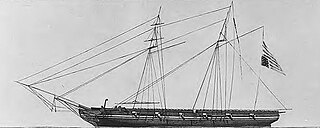
The West Indies Anti-Piracy Operations were a series of military operations and engagements undertaken by the United States Navy against pirates in and around the Antilles. Between 1814 and 1825, the American West Indies Squadron hunted pirates on both sea and land, primarily around Cuba and Puerto Rico. After the capture of Roberto Cofresi in 1825, acts of piracy became rare, and the operation was considered a success, although limited occurrences went on until slightly after the start of the 20th century.
Edmund Roberts was an American diplomat. Appointed by President Andrew Jackson, he served as the United States' first envoy to the Far East, and went on USS Peacock on non-resident diplomatic missions to the courts of Cochinchina, Thailand ("Siam") and Muscat and Oman during the years 1832–6.

Commodore John R. Goldsborough was an officer in the United States Navy. Goldsborough was made a cadet-midshipman in 1824 and as such saw action in the Mediterranean against pirates. In one incident, while in charge of 18 men he attacked and captured a Greek pirate ship with a 58-man crew.
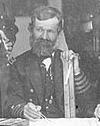
Rear Admiral George Henry Cooper was an officer in the United States Navy. During his long naval career, he served on the African Slave Trade Patrol, and fought in the Second Seminole War, the Mexican War, the American Civil War, and the Korean Expedition, and rose to command of the North Atlantic Squadron.
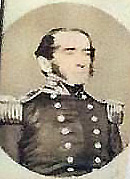
Commodore William J. McCluney was a United States Navy officer whose service included the War of 1812, the Mexican-American War, and the Battle of Ty-ho Bay, China. McCluney commanded two of the flagships—the USS Mississippi and the USS Powhatan—in support of the Perry Expedition to Japan in 1853-1854. As a flag officer, McCluney transported the first Japanese Embassy to the United States aboard his flagship, the USS Roanoke, in 1860 on the last leg of their journey.
